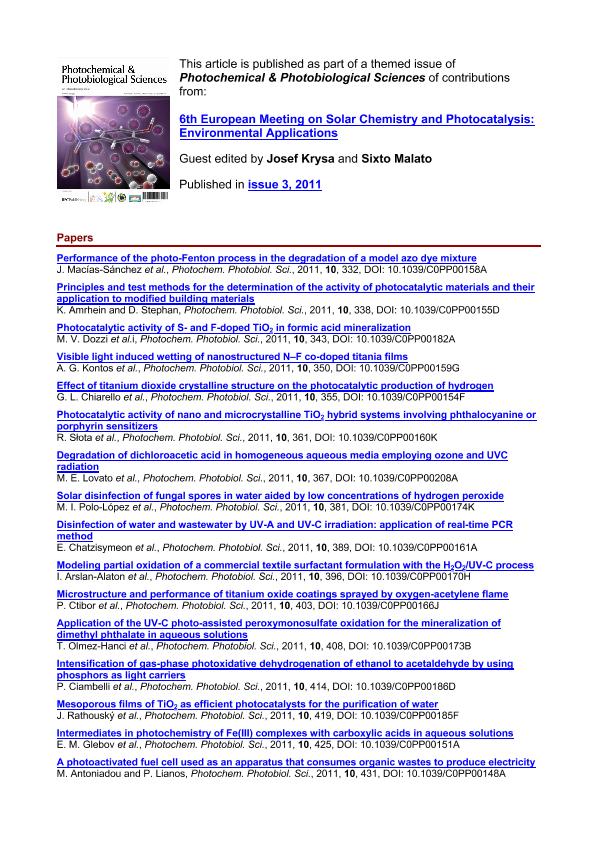Mostrar el registro sencillo del ítem
dc.contributor.author
Lovato, Maria Eugenia

dc.contributor.author
Martin, Carlos Alberto

dc.contributor.author
Cassano, Alberto Enrique

dc.date.available
2017-02-13T20:55:43Z
dc.date.issued
2011-04
dc.identifier.citation
Lovato, Maria Eugenia; Martin, Carlos Alberto; Cassano, Alberto Enrique; Degradation of dichloroacetic acid in homogeneous aqueous media employing ozone and UVC radiation; Royal Society Of Chemistry; Photochemical And Photobiological Sciences; 10; 3; 4-2011; 367-380
dc.identifier.issn
1474-905X
dc.identifier.uri
http://hdl.handle.net/11336/12931
dc.description.abstract
A tentative workable mechanism for dichloroacetic acid decomposition (DCA) in aqueous media employing ozone and UVC radiation has been developed. All experiments were made in a homogeneous medium under assured kinetic control regime. Under no circumstances did a headspace exist in the reactor volume. The starting point of the reaction with UVC radiation was always under the prerequisite of a confirmed state of initial equilibrium conditions for the mixture water-ozone-oxygen at 20 ?C. The explored variables were: (i) DCA initial concentration, (ii) ozone concentration and (iii) fluence rate at the reactor window. The model comprises three parallel reactions: (1) direct photolysis, (2) direct ozonation and (3) ozone + UVC degradation. Complete DCA removal was achieved, and the mass balance, considering DCA disappearance and chloride ion formation, closed within very small error. The combination of ozone and UVC radiation produces a significant amount of hydrogen peroxide as an important reaction by-product. The direct photolysis can be well represented with a six step reaction sequence. The direct ozonation mechanism comprises 22 steps and, with the entire set of kinetic constants completed in this work, it is independent of the reaction pH in the range from 3 to 6.3. Lastly, the associated use of ozone and UVC radiation becomes necessary to consider the existence of radiation absorption by three species, namely DCA, ozone and hydrogen peroxide. The developed system, including the three parallel reactions, led to the proposal of a 37 step reaction mechanism. Finally the reaction kinetics, the mass balances and the radiation field corresponding to this complex system were rigorously modeled and the most significant features of the mathematical representation are briefly described. The simulation results rendered from this model agree very well with the measured experimental data. This outcome will be essential for deriving a complete reactor model that must be appropriate to describe, in the future, the more practical two-phase operating system.
dc.format
application/pdf
dc.language.iso
eng
dc.publisher
Royal Society Of Chemistry

dc.rights
info:eu-repo/semantics/openAccess
dc.rights.uri
https://creativecommons.org/licenses/by-nc-sa/2.5/ar/
dc.subject
Photoreactor
dc.subject
Kinetics
dc.subject
Dichloroacetic
dc.subject
Uv
dc.subject.classification
Ingeniería de Procesos Químicos

dc.subject.classification
Ingeniería Química

dc.subject.classification
INGENIERÍAS Y TECNOLOGÍAS

dc.title
Degradation of dichloroacetic acid in homogeneous aqueous media employing ozone and UVC radiation
dc.type
info:eu-repo/semantics/article
dc.type
info:ar-repo/semantics/artículo
dc.type
info:eu-repo/semantics/publishedVersion
dc.date.updated
2017-02-09T13:52:02Z
dc.journal.volume
10
dc.journal.number
3
dc.journal.pagination
367-380
dc.journal.pais
Reino Unido

dc.description.fil
Fil: Lovato, Maria Eugenia. Consejo Nacional de Investigaciones Científicas y Técnicas. Centro Científico Tecnológico Santa Fe. Instituto de Desarrollo Tecnológico para la Industria Química (i); Argentina. Universidad Nacional del Litoral; Argentina
dc.description.fil
Fil: Martin, Carlos Alberto. Consejo Nacional de Investigaciones Científicas y Técnicas. Centro Científico Tecnológico Santa Fe. Instituto de Desarrollo Tecnológico para la Industria Química (i); Argentina. Universidad Nacional del Litoral; Argentina
dc.description.fil
Fil: Cassano, Alberto Enrique. Consejo Nacional de Investigaciones Científicas y Técnicas. Centro Científico Tecnológico Santa Fe. Instituto de Desarrollo Tecnológico para la Industria Química (i); Argentina. Universidad Nacional del Litoral; Argentina
dc.journal.title
Photochemical And Photobiological Sciences

dc.relation.alternativeid
info:eu-repo/semantics/altIdentifier/doi/http://dx.doi.org/10.1039/c0pp00208a
dc.relation.alternativeid
info:eu-repo/semantics/altIdentifier/url/http://pubs.rsc.org/en/Content/ArticleLanding/2011/PP/C0PP00208A#!divAbstract
Archivos asociados
